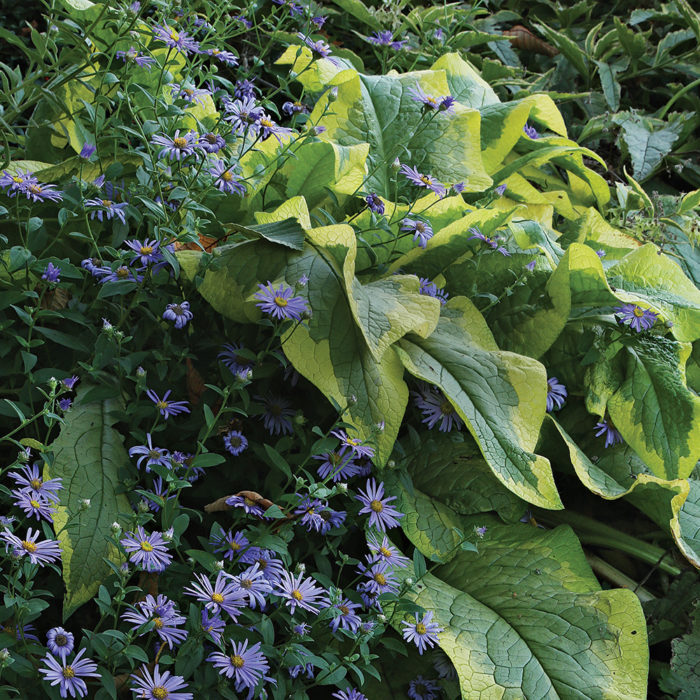
When we moved to British Columbia’s Fraser Valley 10 years ago, my partner and I set out to design a relaxed country garden that celebrates our love of plants. Though many of our best-loved flowers peak in spring and early summer, the beds on our 20-acre property still hold plenty of interest as the season winds down. This is a time for showcasing steadfast performers that gracefully withstand our region’s dry summers, highlighted by a few favorites that show off as the days shorten.
The photos on the following pages were taken just before Labor Day, the unofficial end of summer in both Canada and the United States. Whether you are looking for plants with staying power or some late-season stars, I hope you will find inspiration here.
A floral pick-me-up
‘Axminster Gold’ (photo above) comfrey grabs attention from spring until frost with its bold texture and artful variegation. Siting it in a spot that gets afternoon shade will help to keep the leaves looking fresh. A charming aster sidekick contributes abundant sprays of lavender blue blooms throughout summer and into early fall.
1. ‘Axminster Gold’ comfrey (Symphytum × uplandicum ‘Axminster Gold’, Zones 4–7)
2. ‘Monch’ aster (Aster × frikartii ‘Monch’, Zones 5–10)
A study in silver and gold
A slope provides the perfect spot for creating layers of texture. Here, several plants with silvery foliage are highlighted by a few golden-leaved companions. ‘Primrose Heron’ lambs’ ears walks the line between the two, with foliage that emerges chartreuse in spring, turns silver-gray in summer, then takes on a golden cast in autumn. Bishop’s flower adds airy white umbels from early summer through frost.
1. ‘Baggesen’s Gold’ boxleaf honeysuckle (Lonicera nitida ‘Baggesen’s Gold’, Zones 6–9)
2. ‘Walker’s Low’ catmint (Nepeta racemosa ‘Walker’s Low’, Zones 4–8)
3. ‘Primrose Heron’ lambs’ ears (Stachys byzantina ‘Primrose Heron’, Zones 4–8)
4. ‘Angelina’ sedum (Sedum rupestre ‘Angelina’, Zones 5–8)
5. Sea kale (Crambe maritima, Zones 5–9)
6. Bishop’s flower (Ammi majus, annual)
7. Donkeytail spurge (Euphorbia myrsinites*, Zones 5–9)
Fill up on foliage
Leaves of various scales and shapes create a tapestry effect that carries the garden show into autumn. As colder weather arrives, the geranium and sedum foliage will take on shades of red, bronze, and coral.
1. Bigroot geranium (Geranium macrorrhizum, Zones 4–8)
2. ‘Angelina’ sedum (Sedum rupestre ‘Angelina’, Zones 5–8)
3. Lavender cotton (Santolina chamaecyparissus, Zones 6–9)
4. Stinking hellebore (Helleborus foetidus, Zones 5–9)
5. Lambs’ ears (Stachys byzantina, Zones 4–8)
6. Boxleaf hebe (Hebe buxifolia, Zones 8–10)
7. Blue oat grass (Helictotrichon sempervirens, Zones 4–8)
8. Crocus Rose shrub rose (Rosa ‘Ausquest’, Zones 5–9)
Fresh flowers at season’s end
This large-leaved bergenia is a spring bloomer, but in our garden it always gives a repeat performance later in the season. Worth adding to the garden for its foliage alone, it provides contrast for self-sown seedlings of ‘Lime Zinger’ and ‘Matrona’ sedums, both excellent foliage plants in their own right. The vine serving as a backdrop is ‘Blue Bird’ clematis, a vigorous spring-to-summer bloomer that follows up its floral show with an attractive curtain of foliage studded with fluffy seed heads.
1. Large-leaf bergenia (Bergenia ciliata, Zones 5–8)
2. ‘Matrona’ and ‘Lime Zinger’ sedum seedlings (Hylotelephium ‘Matrona’ and ‘Lime Zinger’, Zones 4–9)
3. ‘Blue Bird’ clematis (Clematis macropetala ‘Blue Bird’, Zones 4–10)
Dramatic architecture and color
Although ‘Vicar’s Mead’ angelica is a biennial or, at best, a short-lived perennial, it is well worth adding to a bed. Removing the flowers might help the plant last longer, but how could you? Instead, allow it to reseed in moist, fertile soil, or collect ripe seed at season’s end to ensure future generations. Its burgundy stems and leaves provide bold contrast for fine-textured artemesia and Japanese forest grass. Black Scallop ajuga provides a color echo at ground level and helps to control weeds.
1. ‘Vicar’s Mead’ angelica (Angelica sylvestris ‘Vicar’s Mead’, Zones 4–9)
2. ‘Powis Castle’ artemisia (Artemisia ‘Powis Castle’, Zones 6–9)
3. Variegated Japanese forest grass (Hakonechloa macra ‘Albovariegata’, Zones 5–8)
4. Black Scallop ajuga (Ajuga reptans ‘Binblasca’, Zones 4–9)
Easygoing path edgers
‘Silver Mound’ artemisia is a low-maintenance filler, growing quickly to form 12-inch cushions of finely cut leaves. A purple-leaved New Zealand burr spreads at its feet, adding a wash of warm color to the mix, while bright tall verbena blooms appear to float above on wiry, nearly leafless stems. The grass in the background is a wild plant that grew on its own; a similar effect could be achieved by planting an ornamental cultivar like ‘Karl Foerster’ feather reed grass (Calamagrostis acutiflora ‘Karl Foerster’, Zones 5–8).
1. ‘Silver Mound’ artemisia (Artemisia schmidtiana ‘Silver Mound’, Zones 3–7)
2. New Zealand burr (Acaena inermis ‘Purpurea’, Zones 6–10)
3. Tall verbena (Verbena bonariensis, Zones 7–10)
Stars with staying power
Everyone needs plants that they can count on. Here are a few low-maintenance favorites from our gardens that look great all season without a lot of fuss.
*Invasive alert: Donkeytail spurge (Euphorbia myrsinites)
This plant is considered invasive in CO, OR, UT, and WA.
Please visit invasiveplantatlas.org for more information.
Thomas Hobbs and his partner, Brent Beattie, own and operate Southlands Nursery in Vancouver, British Columbia.
Photos: Carol Collins
Fine Gardening Recommended Products

Scotts Cordless Grass-Shear/Shrub-Trimmer Combo

DeWalt Variable-Speed Cordless Reciprocating Saw

Black and Decker 22-inch Cordless Hedge Trimmer
































Comments
Log in or create an account to post a comment.
Sign up Log in